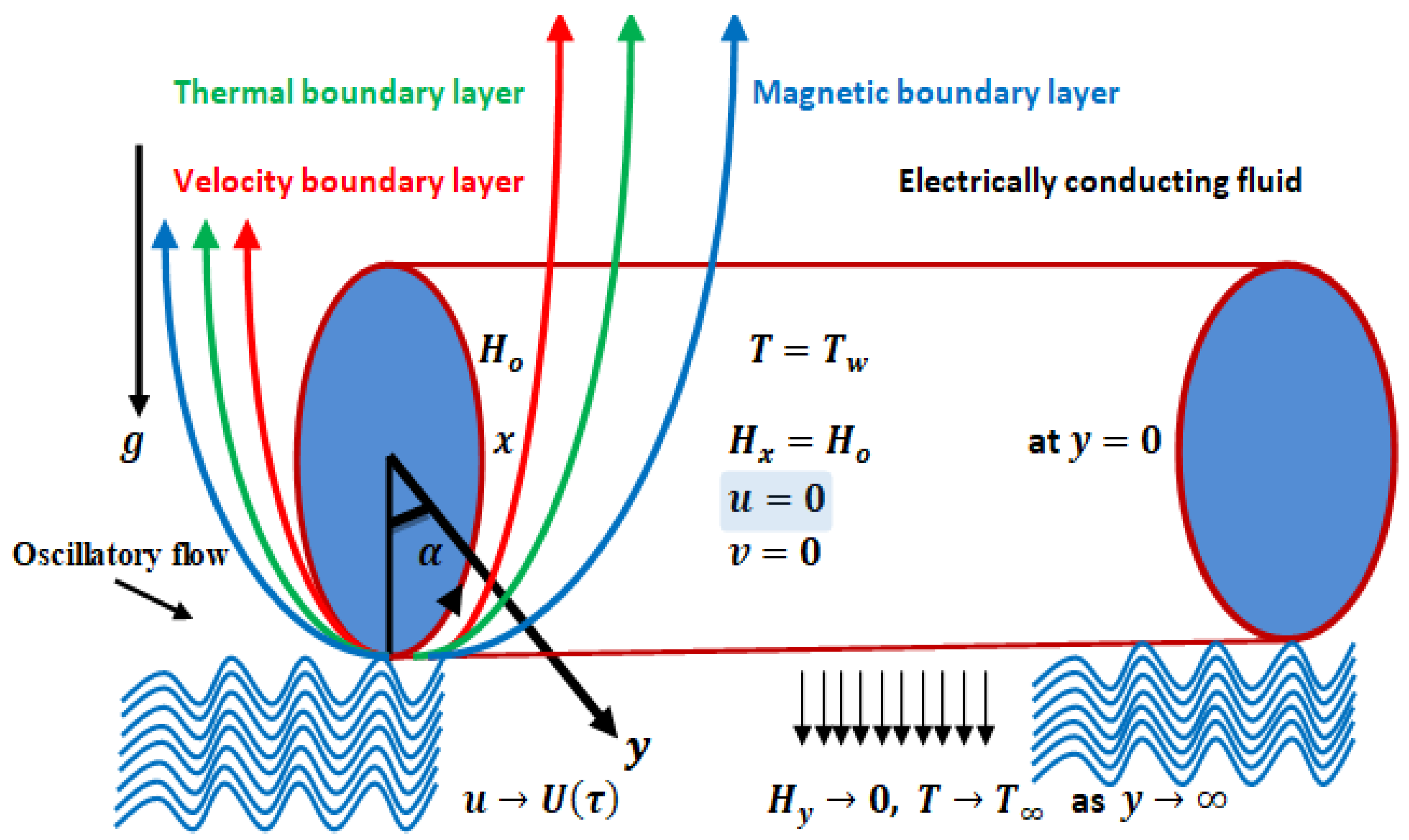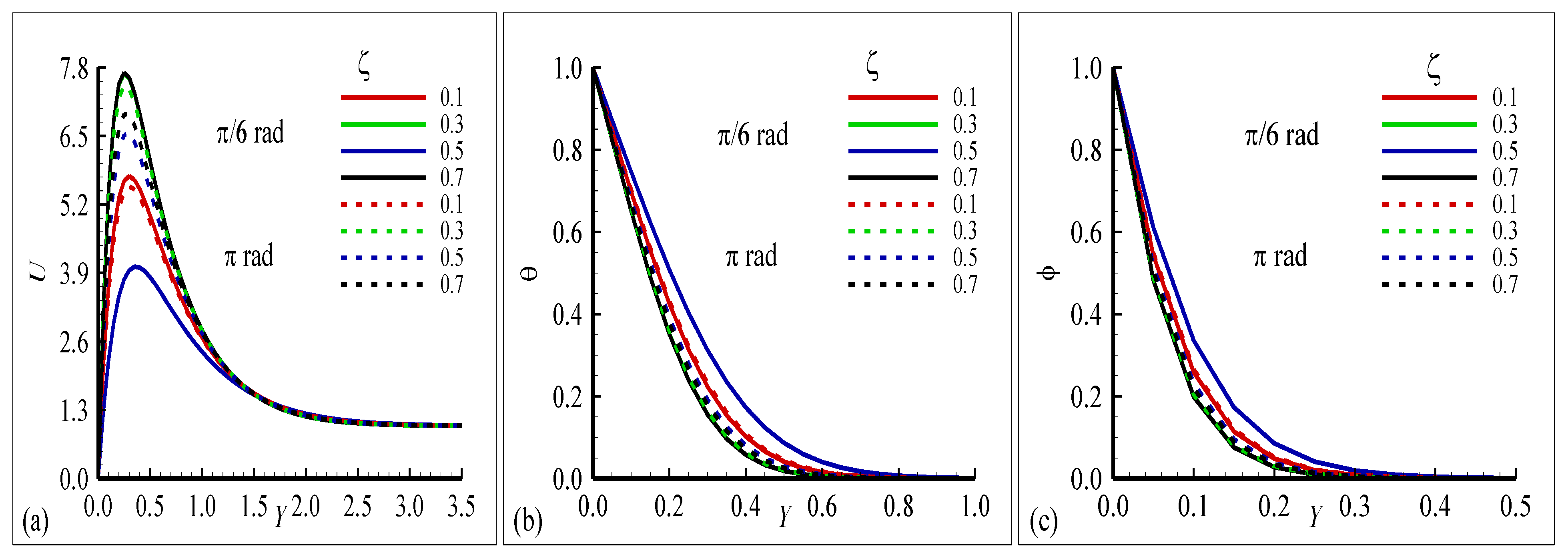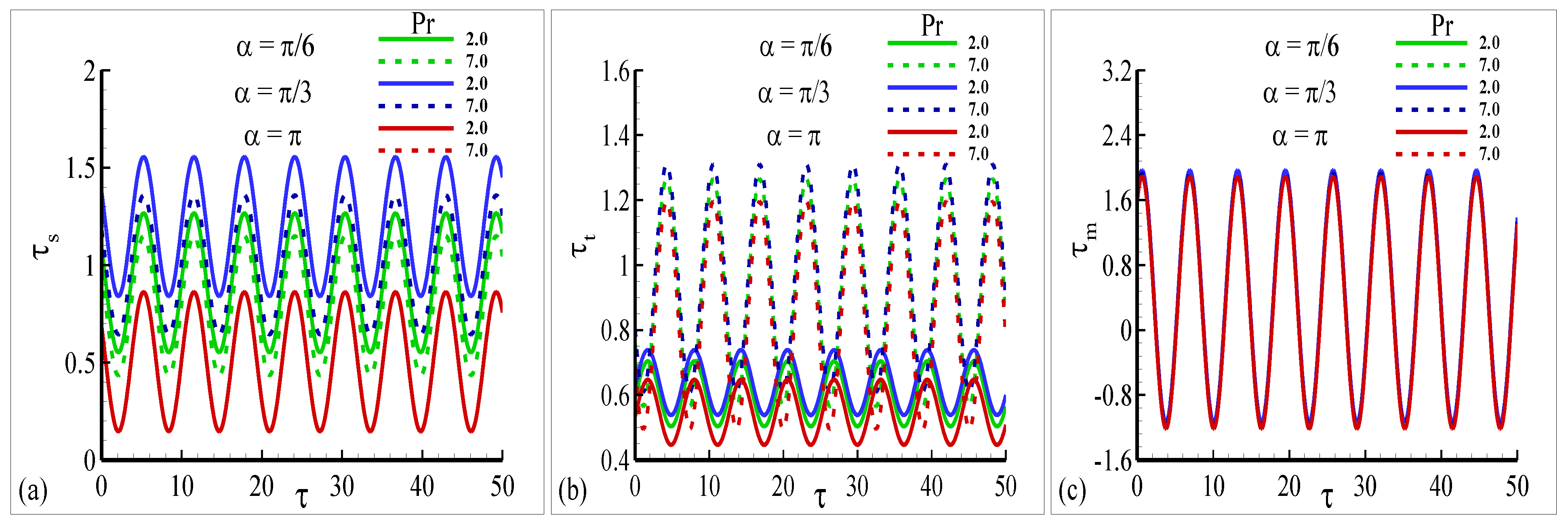Oscillatory and Periodical Behavior of Heat Transfer and Magnetic Flux along Magnetic-Driven Cylinder with Viscous Dissipation and Joule Heating Effects
Abstract
1. Introduction
2. Flow Formulation
3. Computing Technique
4. Results and Discussion
4.1. Non-Oscillating/Steady Plots of Velocity , Temperature , Magnetic Region
4.2. Oscillatory Representations of Transient Shearing Stress , Heat Rate , Magnetic Flux
5. Conclusions
- The prominent amplitude quantity of the velocity was examined at = 3.0 across angle , but enhanced results of Joule heating for the temperature plot were deduced at angle .
- Prominent improvement in temperature was investigated at angles , and with the Joule heating impacts. The result was theoretically possible since viscous dissipation and Joule heating have been employed as source inputs for assessing the transfer efficiency of heat in magnetically conducting fluids.
- Since the force of buoyancy works like an external pressure component to increase fluid speed, the enhanced Pr through viscous dissipation and Joule heating led to the noticeable augmentation in electromagnetic diagrams.
- The higher amplitude of oscillation in at each circular position was evaluated under viscous dissipation and Joule heating at angle . This was technically predicted since the frequency of fluid movement rises due to gravitational pull, which improves the intensity of the oscillating heat and oscillating magnetic flux of water-based fluids.
- Assuming the significance of the three angles , and , the minimal magnitude of oscillation in a magnetic flux was investigated due to viscous dissipation and Joule heating.
- The magnitude of fluctuating heat transfer was improved under maximum Pr at every location , and compared to other plots. For each Pr option around the entire magnetized cylinder, the same behavior in a magnetic flux with suitable magnitude was developed.
Author Contributions
Funding
Data Availability Statement
Conflicts of Interest
Nomenclature
| , , U | Velocity along and -direction (m s−1) |
| , , | Magnetic velocities along and directions (Tesla) |
| Dynamic viscosity (kg m−1 s−1) | |
| Kinematic viscosity (m2 s−1) | |
| Fluid density (kg m−3) | |
| Gravitational acceleration (m s−2) | |
| Thermal expansion coefficient (K−1) | |
| Magnetic permeability (H m−1) | |
| Thermal diffusivity (m2 s−1) | |
| T | Temperature (K) |
| Specific heat (J kg−1 K−1) | |
| Electrical conductivity (s m−1) | |
| Ambient temperature (K) | |
| Reynolds number | |
| Grashof number | |
| Joule heating parameter | |
| Shearing stress (Pa) | |
| Magnetic force parameter | |
| Mixed convection parameter | |
| Dimensionless temperature | |
| Magnetic Prandtl number | |
| Pr | Prandtl number |
| Eckert number | |
| Temperature difference |
References
- Poornima, T.; Sreenivasulu, P.; Bhaskar Reddy, N. Chemical reaction effects on an unsteady MHD mixed convective and radiative boundary layer flow over a circular cylinder. J. Appl. Fluid Mech. 2016, 9, 2877–2885. [Google Scholar] [CrossRef]
- Shafie, S.; Mahat, R.; Januddi, F. Numerical Solutions of Mixed Convection Flow Past a Horizontal Circular Cylinder with Viscous Dissipation in Viscoelastic Nanofluid. J. Adv. Res. Micro Nano Eng. 2020, 1, 24–37. [Google Scholar]
- Mohamed, M.K.A.; Sarif, N.M.; Noar, N.A.Z.M.; Salleh, M.Z.; Ishak, A.M. Mixed convection boundary layer flow on a horizontal circular cylinder in a nanofluid with viscous dissipation effect. Malays. J. Fundam. Appl. Sci. 2018, 14, 32–39. [Google Scholar]
- Anwar, I.; Amin, N.; Pop, I. Mixed convection boundary layer flow of a viscoelastic fluid over a horizontal circular cylinder. Int. J. Non-Linear Mech. 2008, 43, 814–821. [Google Scholar] [CrossRef]
- Aboud, E.D.; Rashid, H.K.; Jassim, H.M.; Ahmed, S.Y.; Khafaji, S.O.W.; Hamzah, H.K.; Ali, F.H. MHD effect on mixed convection of annulus circular enclosure filled with Non-Newtonian nanofluid. Heliyon 2020, 6, e03773. [Google Scholar] [CrossRef] [PubMed]
- Ismail, M.A.; Mohamad, N.F.; Ilias, M.R.; Shafie, S. MHD Effect on Unsteady Mixed Convection Boundary Layer Flow past a Circular Cylinder with Constant Wall Temperature. J. Phys. Conf. Ser. 2017, 890, 012054. [Google Scholar] [CrossRef]
- Makanda, G.; Shaw, S.; Sibanda, P. Effects of radiation on MHD free convection of a Casson fluid from a horizontal circular cylinder with partial slip in non-Darcy porous medium with viscous dissipation. Bound. Value Probl. 2015, 2015, 75. [Google Scholar] [CrossRef]
- Gireesha, B.J.; Mahanthesh, B.; Gorla, R.S.R.; Krupalakshmi, K.L. Mixed convection two-phase flow of Maxwell fluid under the influence of non-linear thermal radiation, non-uniform heat source/sink and fluid-particle suspension. Ain Shams Eng. J. 2018, 9, 735–746. [Google Scholar] [CrossRef]
- Al-Farhany, K.; Al-Muhja, B.; Loganathan, K.; Periyasamy, U.; Ali, F.; Sarris, I.E. Analysis of Convection Phenomenon in Enclosure Utilizing Nanofluids with Baffle Effects. Energies 2022, 15, 6615. [Google Scholar] [CrossRef]
- Al-Mdallal, Q.; Prasad, V.R.; Basha, H.T.; Sarris, I.; Akkurt, N. Keller box simulation of magnetic pseudoplastic nano-polymer coating flow over a circular cylinder with entropy optimisation. Comput. Math. Appl. 2022, 118, 132–158. [Google Scholar] [CrossRef]
- Zhang, X.F.; Yang, J.C.; Ni, M.J.; Zhang, N.M.; Yu, X.G. Numerical simulations of flow around dual tandem circular cylinders under a strong axial magnetic field. Phys. Fluids 2023, 35, 023604. [Google Scholar] [CrossRef]
- Naghshineh, N.; Barlow, N.S.; Samaha, M.A.; Weinstein, S.J. Asymptotically consistent analytical solutions for the non-Newtonian Sakiadis boundary layer. Phys. Fluids 2023, 35, 053103. [Google Scholar] [CrossRef]
- Khan, A.S.; Xu, H.Y.; Nie, Y.; Idrees, M.; Khan, N.U.S. Numerical examination of wall properties for the magnetohydrodynamics stagnation point flow of micro-rotating fluid subject to weak concentration. Phys. Fluids 2023, 35, 053102. [Google Scholar] [CrossRef]
- Wu, X.; Liu, C.; Bai, Y.; Zhang, Y.; Pan, M.; Wang, X. Magnetic diffusion of time distributed-order Maxwell fluid in boundary layer under the action of induced magnetic field. Phys. Fluids 2023, 35, 053108. [Google Scholar]
- Hayat, T.; Shaheen, U.; Shafiq, A.; Alsaedi, A.; Asghar, S. Marangoni mixed convection flow with Joule heating and nonlinear radiation. AIP Adv. 2015, 5, 077140. [Google Scholar] [CrossRef]
- Maurya, P.K.; Deo, S.; Maurya, D.K. Couple stress fluid flow enclosing a solid sphere in a porous medium: Effect of magnetic field. Phys. Fluids 2023, 35, 072006. [Google Scholar] [CrossRef]
- Routa, C.; Balaji, P.; Sahu, A.K. Numerical investigation of effect of surface pattern and rotation on power-law fluid flow and heat transfer around a cylinder in laminar flow regime. Phys. Fluids 2023, 35, 073101. [Google Scholar] [CrossRef]
- Lv, J.; Zhang, Y. Numerical study of the natural transition of water boundary layers over heated/cooled flat plates. Phys. Fluids 2023, 35, 064106. [Google Scholar]
- Ankush, A.; Narayana, P.A.L.; Sahu, K.C. Mixed convection instability in a viscosity stratified flow in a vertical channel. Phys. Fluids 2023, 35, 064114. [Google Scholar] [CrossRef]
- Govindarajulu, K.; Subramanyam Reddy, A. Magnetohydrodynamic pulsatile flow of third grade hybrid nanofluid in a porous channel with Ohmic heating and thermal radiation effects. Phys. Fluids 2022, 34, 013105. [Google Scholar] [CrossRef]
- Ilin, K.; Morgulis, A. The effect of boundary conditions on the stability of two-dimensional flows in an annulus with permeable boundary. Phys. Fluids 2022, 34, 074117. [Google Scholar] [CrossRef]
- Kumar, G.C.; Reddy, K.J.; Konijeti, R.K.; Reddy, M.N. Non-uniform heat source/sink and joule heating effects on chemically radiative MHD mixed convective flow of micropolar fluid over a stretching sheet in porous medium. In Defect and Diffusion Forum; Trans Tech Publications Ltd.: Bäch, Switzerland, 2018; Volume 388, pp. 281–302. [Google Scholar]
- Kumar, P.V.; Ibrahim, S.M.; Lorenzini, G. Impact of thermal radiation and Joule heating on MHD mixed convection flow of a Jeffrey fluid over a stretching sheet using homotopy analysis method. Int. J. Heat Technol. 2017, 35, 978–986. [Google Scholar] [CrossRef]
- Roy, N.C.; Akther, P.; Halder, A.K. MHD mixed convection flow of a micropolar fluid past a wedge fixed in a fluctuating free stream and surface temperature. Dhaka Univ. J. Sci. 2016, 64, 65–70. [Google Scholar] [CrossRef][Green Version]
- Roy, N.C.; Hossain, M.A. Unsteady laminar mixed convection boundary layer flow near a vertical wedge due to oscilations in the free-stream and surface temperature. Int. J. Appl. Mech. Eng. 2016, 21, 169–186. [Google Scholar] [CrossRef]
- Firoza, M.N.; Roy, N.C.; Hossain, M.A. Conjugate heat and mass transfer on fluctuating mixed convection flow along a vertical wedge with thermal radiation. Int. J. Appl. Mech. Eng. 2017, 22, 539–565. [Google Scholar] [CrossRef]
- Hossain, M.A.; Roy, N.C.; Siddiqa, S. Unsteady mixed convection dusty fluid flow past a vertical wedge due to small fluctuation in free stream and surface temperature. Appl. Math. Comput. 2017, 293, 480–492. [Google Scholar] [CrossRef]
- Maranna, T.; Sneha, K.N.; Mahabaleshwar, U.S.; Sarris, I.E.; Karakasidis, T.E. An Effect of Radiation and MHD Newtonian Fluid over a Stretching/Shrinking Sheet with CNTs and Mass Transpiration. Appl. Sci. 2022, 12, 5466. [Google Scholar] [CrossRef]
- Mabood, F.; Fatunmbi, E.O.; Benos, L.; Sarris, I.E. Entropy Generation in the Magnetohydrodynamic Jeffrey Nanofluid Flow over a Stretching Sheet with Wide Range of Engineering Application Parameters. Int. J. Appl. Comput. Math. 2022, 8, 98. [Google Scholar] [CrossRef]
- Alharbi, K.A.M.; Ullah, Z.; Jabeen, N.; Ashraf, M. Magnetohydrodynamic and Thermal Performance of Electrically Conducting Fluid along the Symmetrical and Vertical Magnetic Plate with Thermal Slip and Velocity Slip Effects. Symmetry 2023, 15, 1148. [Google Scholar] [CrossRef]
- Ullah, Z.; Ahmad, H.; Khan, A.A.; Aldhabani, M.S.; Alsulami, S.H. Thermal conductivity effects on mixed convection flow of electrically conducting fluid along vertical magnetized plate embedded in porous medium with convective boundary condition. Mater. Today Commun. 2023, 35, 105892. [Google Scholar] [CrossRef]
- Ullah, Z.; Jabeen, N.; Khan, M.U. Amplitude and Phase Angle of Oscillatory Heat Transfer and Current Density along a Nonconducting Cylinder with Reduced Gravity and Thermal Stratification Effects. Mathematics 2023, 11, 2134. [Google Scholar] [CrossRef]
- Khan, M.N.; Ullah, Z.; Wang, Z.; Gamaoun, F.; Eldin, S.M.; Ahmad, H. Analysis of fluctuating heat and current density of mixed convection flow with viscosity and thermal conductivity effects along horizontal nonconducting cylinder. Case Stud. Therm. Eng. 2023, 46, 103023. [Google Scholar] [CrossRef]
- Ullah, Z.; Ehsan, M.; Ahmad, H.; Ilyas, A. Combined effects of MHD and slip velocity on oscillatory mixed convective flow around a non-conducting circular cylinder embedded in a porous medium. Case Stud. Therm. Eng. 2022, 38, 102341. [Google Scholar] [CrossRef]
- Chawla, S.S. Magnetohydrodynamic oscillatory flow past a semi-infinite flat plate. Int. J. Non-Linear Mech. 1971, 6, 117–134. [Google Scholar] [CrossRef]
- Dai, B.; Qi, H.; Liu, S.; Zhong, Z.; Li, H.; Song, M.; Ma, M.; Sun, Z. Environmental and economical analyses of transcritical CO2 heat pump combined with direct dedicated mechanical subcooling (DMS) for space heating in China. Energy Convers. Manag. 2019, 198, 111317. [Google Scholar] [CrossRef]
- Dai, B.; Wang, Q.; Liu, S.; Wang, D.; Yu, L.; Li, X.; Wang, Y. Novel configuration of dual-temperature condensation and dual-temperature evaporation high-temperature heat pump system: Carbon footprint, energy consumption, and financial assessment. Energy Convers. Manag. 2023, 292, 117360. [Google Scholar] [CrossRef]









| Chawla [35] | Present Results | Percentage Error | |
|---|---|---|---|
| 1 | 0.3204 | 0.3210 | 0.1872% |
| 10 | 0.3210 | 0.3207 | 0.0934% |
| 100 | 0.3244 | 0.3196 | 1.4796% |
| 0.0 | 0.1632 | 0.1514 | 0.1431 | 0.1397 |
| 0.2 | 0.1128 | 0.1367 | 0.1243 | 0.1156 |
| 0.4 | 0.0956 | 0.1013 | 0.1017 | 0.1073 |
| 0.6 | 0.0890 | 0.0987 | 0.0987 | 0.1011 |
| 0.8 | 0.0853 | 0.0913 | 0.0951 | 0.0989 |
| 1.0 | 0.0821 | 0.0885 | 0.0909 | 0.0933 |
| 1.2 | 0.0834 | 0.0831 | 0.0875 | 0.0880 |
| 1.4 | 0.0786 | 0.0792 | 0.0710 | 0.0871 |
| 1.6 | 0.0791 | 0.0835 | 0.0797 | 0.0913 |
| 1.8 | 0.0798 | 0.0857 | 0.0841 | 0.0957 |
| 2.0 | 0.0814 | 0.0891 | 0.0879 | 0.0993 |
| 2.2 | 0.0824 | 0.0919 | 0.0911 | 0.1015 |
| 2.4 | 0.0873 | 0.0995 | 0.0959 | 0.1037 |
| 2.6 | 0.0889 | 0.1031 | 0.1020 | 0.1071 |
| 2.8 | 0.1145 | 0.1169 | 0.1095 | 0.1131 |
| 3.0 | 0.1170 | 0.1187 | 0.1131 | 0.1179 |
| 0.1627 | 0.1439 | 0.1413 | 0.1337 |
Disclaimer/Publisher’s Note: The statements, opinions and data contained in all publications are solely those of the individual author(s) and contributor(s) and not of MDPI and/or the editor(s). MDPI and/or the editor(s) disclaim responsibility for any injury to people or property resulting from any ideas, methods, instructions or products referred to in the content. |
© 2023 by the authors. Licensee MDPI, Basel, Switzerland. This article is an open access article distributed under the terms and conditions of the Creative Commons Attribution (CC BY) license (https://creativecommons.org/licenses/by/4.0/).
Share and Cite
Ullah, Z.; Aldhabani, M.S.; Qaiser, M.A. Oscillatory and Periodical Behavior of Heat Transfer and Magnetic Flux along Magnetic-Driven Cylinder with Viscous Dissipation and Joule Heating Effects. Mathematics 2023, 11, 3917. https://doi.org/10.3390/math11183917
Ullah Z, Aldhabani MS, Qaiser MA. Oscillatory and Periodical Behavior of Heat Transfer and Magnetic Flux along Magnetic-Driven Cylinder with Viscous Dissipation and Joule Heating Effects. Mathematics. 2023; 11(18):3917. https://doi.org/10.3390/math11183917
Chicago/Turabian StyleUllah, Zia, Musaad S. Aldhabani, and Muhammad Adnan Qaiser. 2023. "Oscillatory and Periodical Behavior of Heat Transfer and Magnetic Flux along Magnetic-Driven Cylinder with Viscous Dissipation and Joule Heating Effects" Mathematics 11, no. 18: 3917. https://doi.org/10.3390/math11183917
APA StyleUllah, Z., Aldhabani, M. S., & Qaiser, M. A. (2023). Oscillatory and Periodical Behavior of Heat Transfer and Magnetic Flux along Magnetic-Driven Cylinder with Viscous Dissipation and Joule Heating Effects. Mathematics, 11(18), 3917. https://doi.org/10.3390/math11183917





